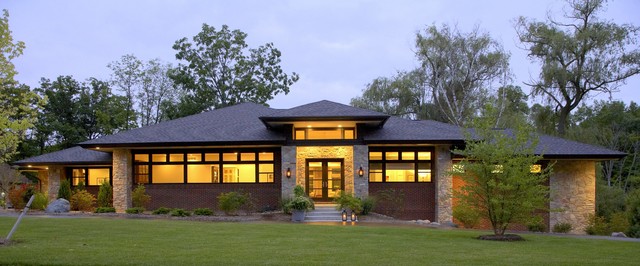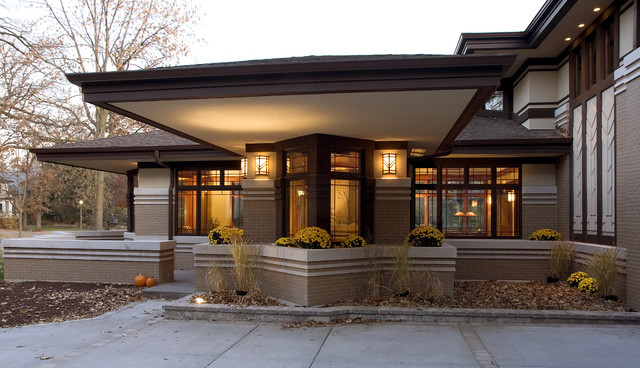Micah has very good examples of his work and a good, brief overview of his history as a designer. I also enjoyed her video on the falling water home.
Morgan has a great recap of Wright's history behind the horizontal design style and very good examples.
Sunday, September 27, 2015
Friday, September 25, 2015
Frank Lloyd Wright
Frank Lloyd Wright was an architect who did commercial designs but focused on residential homes. He developed an "American" architecture but called his personal style of architecture "Prairie Style". Wright's color pallet was derived from indigenous plants within the Midwest. The exterior of his Prairie style designs had a hipped roof and strong horizontal profile. He used horizontal bricks, concrete slabs, and other materials to emphasize this design. His goal was integrate the house, material and landscape. The interior of his homes focused on the family. The fireplaces was always the center of the home. Other characteristics included built in furniture, stained glass windows and unique light fixtures. He would often design unique furniture and light fixtures for each of the homes he designed for the home owner.
Previous Application - Designed by Wright
Other Prairie Style Homes


Friday, September 18, 2015
Protomodernism
1898 The Vienna Secession's interest in culture and design brought about word wide advances in art, history, psychology and philosophy. This time had no ties to previous architecture or interior design which helped them lead the way for the Modernism and Art Deco Movements. The design style protested against Historicism and did not embrace Art Nouveau, however, movement was ideal.
Gustav Klimt, an Austrian symbolist painter, was one of the most prominent members of the Austrian Secession Movement. He believed that there should be unity between art and design. His paintings were a play on the subconscious and included gold paint to create dramatic effect.
Otto Wagner was another designer of the period who designed his furniture to relate to his architecture. Some of his creations include the Postal Savings Bank, Postal Savings Bank Chair and Stool.
Josef Hofman was another important designer. He created the Palais Stoclet building as well as furniture. Some of his furniture pieces include the Morris Chair, Armloffel Chair, Kubus Chair, Palais Stoclet Chair, and Circular Fledermaus Table.
Adolf Loos was influenced by the Arts and Crafts style and created the Cafe Museum Chair.
Applications:
Palais Stoclet interior
Modern Applications:

Moderation of Palais Stoclet Chair
Sunday, September 6, 2015
Art Nouveau Review
Alicia S. - I really like how she chose a few important designers from the period and went into more depth about their design style, their use of materials and important pieces they have created. Also, her pictures were strong and enhanced the information she gave us in the previous paragraphs.
John - He really hit the main points of the era and focused on the inspiration of nature. His examples were perfect for showing the curved lines that represent insect wings.
John - He really hit the main points of the era and focused on the inspiration of nature. His examples were perfect for showing the curved lines that represent insect wings.
Friday, September 4, 2015
Art Nouveau
Victor Horta House:
https://www.youtube.com/watch?v=SZVli-rlPCI
The Art Nouveau Movement was from 1890-1910. This movement was lead by Belgium and France but became popular throughout Europe. used nature's elements, flowers, birds, vines, insects, as inspiration. This period's designers and painters had an admiration for Japanese art and inspired many paintings.






https://www.youtube.com/watch?v=SZVli-rlPCI
The Art Nouveau Movement was from 1890-1910. This movement was lead by Belgium and France but became popular throughout Europe. used nature's elements, flowers, birds, vines, insects, as inspiration. This period's designers and painters had an admiration for Japanese art and inspired many paintings.
Characteristics of the movement include the rejection of the Victorian style, based on nature, the use of modern techniques, embracing manufacturing, electric lighting, and curvilinear forms.
Curved lines were dominant, "Whiplash" was the most visible motif. Decorative ornamentation consisted of abstract forms that were inspired by flowers, vines, shells, bird feathers, and insect wings.
Victor Horta was the most influential designer of the period. His designs included unique iron railings and hardware, large glass frames, and an asymmetrical facade.
Henry Van de Velde contributed sculptural and ergonomic furniture design including the armchair.
Hector Guimard was the most significant figure in Paris. He designed residential and street furniture which looked hand crafted but were made in factories.
Antoni Gaudi was a significant designer in Spain who continued using curves and unusual decorative details to create structures that resemble fantasy. He used glass, masony, ceramic tile, and wood seamlessly.
Previous Applications:


Modern Applications:


Subscribe to:
Comments (Atom)